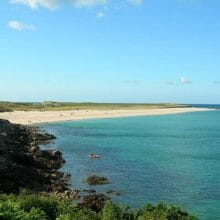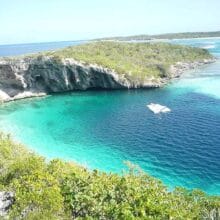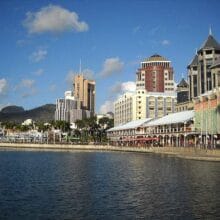10 Natural Wonders of the Caribbean

This blog posts unveils 10 natural wonders of the Caribbean Islands.

When you see a single Flamingo, you would stop to stare and appreciate the bird’s pink color, black beak, and long, ultra-thin legs.
What if you come across a flock of Pink Flamingos, trying to find food in a lake or in a lagoon? You would immediately shoot them in your camera-right?
10 Natural Wonders of the Caribbean
That’s what you see in the video above.
-
Flamingos of Cayo Coco
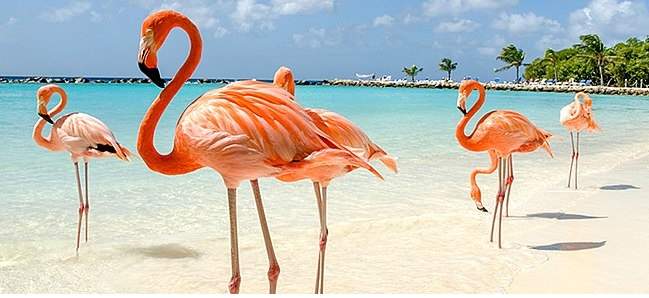 The stunning attractions include unique birds, sea coves, blue holes, unusual beaches, lush rainforests, and many more.
The stunning attractions include unique birds, sea coves, blue holes, unusual beaches, lush rainforests, and many more.
These Caribbean Natural Wonders are spread across various islands in the Caribbean Sea, and Atlantic Ocean.
To watch the graceful flamingo flocks, the best place in the Caribbean region is Cayo Coco, an island of Cuba.
The white sand beaches, birds, sunny beaches pull large number of tourists from the United States, and Canada.
To serve them, this little Cuban island is studded with numerous luxury resorts. Together, the resorts have an incredible 5000 rooms. There is an ambitious plan of creating 32,000 rroms for the burgeoning tourists to Cayo Coco.
Cayo Coco is just a cay (key) and it is part of an archipelago of Cays known as Jardines del Rey.
In order to see this Caribbean wonder, you need to get to Moron, a city in central Cuba.
A road takes you to the Moron Coast. The same road is connected to a 27 km long causeway across the Perros Bay. Driving across the sea is breezy, and the sight is sweeping. You can reach the Cayo Coco Island in less than an hour by car.
Renaissance Island, one of Aruba’s archipelagos is also a favorite place in the Caribbean region for the attractive Flamingos.
Aruba Island belongs to the Dutch.
-
El Yunque National Forest

If this video clip arrested your attention for a few minutes, you would have noticed your eyes were wide as you watched. Naturally, you would start visualizing a personal visit to El Yunque National Forest and explore its belly, and shoulder.
This breathtaking rainforest is in Puerto Rico, a Caribbean Island. After you have exited from the forest with your guide, you would agree to its status as one of the natural wonders of Caribbean.
 The entire slopes of Sierra de Luquillo Mountains are covered with the dense rainforest.
The entire slopes of Sierra de Luquillo Mountains are covered with the dense rainforest.
El Yunque National Forest is home to numerous animals and birds, reptiles, and insects, many of which are endemic to Puerto Rico.
The thick woods receive rain almost throughout the year, thus keeping the place ever green.
En Yunque forest is one of the breathtaking Caribbean attractions.
-
The Baths
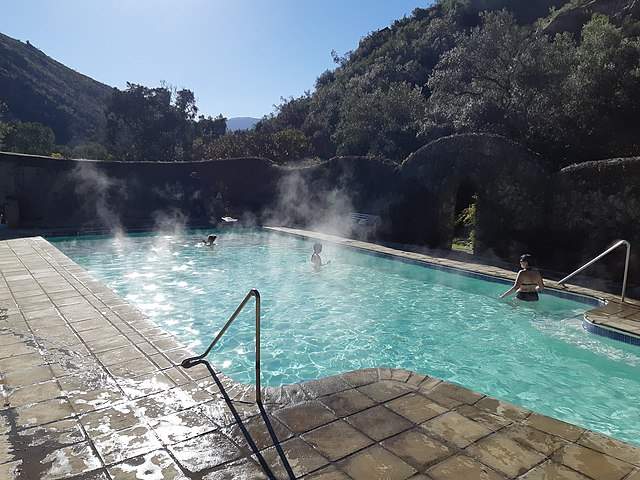 A series of beach with boulders whose surface is smooth as butter, are located on an island called Virgin Goda. It belongs to the British Virgin Islands that are floating in the Caribbean Sea.
A series of beach with boulders whose surface is smooth as butter, are located on an island called Virgin Goda. It belongs to the British Virgin Islands that are floating in the Caribbean Sea.
The beach has a few caves that are open for public entry.
In addition to the caves on the shore, there are underwater caves too in Virgin Goda Island.
Both the boulders and the underwater caves are considered as the natural wonders of the Caribbean.
-
The Mesoamerican Barrier reef system in Roatan Island
Roatan is one of the islands that belong to Honduras, a Central American country in the Caribbean Region.
Next to the Great Barrier Reef of Australia, the Mesoamerican Barrier Reef System is the most awesome marine life. The long reef complex runs to over 1200 km long.
It’s spread over several countries namely:
- Mexico
- Belize
- Gautemela
- Honduras
It is surprisingly protected by all the countries by way forming preserves, national parks, biosphere reserve, Marine Park, and marine reserves.
Such diverse marine lives naturally attract veteran scuba divers to Raotan Island.
Several American states operate flight service to this small Honduras Island.
For a thrilling travel option, you hop on to a ferry leaving the harbor of La Ceba, one of the portal cities in northern Honduras.
Roatan Island is also known for several white sand beaches; but these beaches are located on the west coast of the island.
From the mainland Honduras, Roatan Island is 65 km north, in the Caribbean Sea.
-
Stingray City, Cayman Islands
 This is a Stingray with a long tail. It is a unique fish that is found to be living in the oceans and seas that are lapping tropical lands.
This is a Stingray with a long tail. It is a unique fish that is found to be living in the oceans and seas that are lapping tropical lands.
We have heard of whale watching and dolphin watching tours in various places in the world.
But Stingray watching is possible only in Cayman Islands. Inexplicably, you see them swimming in large numbers here.
Usually, they don’t swim near the surface; they prefer ocean beds. However, in Cayman Islands, they are seen so near the surface that even snorkelers can swim along with Stingrays..
One of the three Cayman Islands is Grand Cayman. It is the largest of the three Cayman Islands.
On this island is where people gather in thousands to watch schools of Stingrays.
I guess, the fish somehow senses, the human like them. Over the years, the Stingrays allow the people to touch them, and even feed them.
There are a few sandbars on Grand Cayman. Water used to be shallow near these sandbars.
This is where you can watch the Stingrays in large numbers and that’s why, it is known as Stingray City,
It is said to be one of the Caribbean attractions.
To join the fun with the Stingrays, you can ask around for guided Stingray sighting tours. I remember reading a number of boat owner’s offer this tour to Stingray City.
For your information, the Cayman Islands fall under the British Overseas Territories.
-
Bonaire Marine Park
This is a small portion of the Klein Bonaire, an islet of Bonaire Island, one of the three Dutch Caribbean Islands.
This islet is where, no one lives. But, I guess one can spot several species of seabirds that prey on the marine creatures.
The three Dutch Caribbean Islands are known shortly as ABC islands (Aruba, Bonaire, and Curacao).
The Bonaire Marine Park is visited mainly by the scuba divers from all over the world to witness, some extraordinary marine lives that are not seen anywhere in the world.
As one of the oldest marine parks in the world, it covers a huge area comprising 6700 acres!
When you dive a bit deep in the Caribbean Sea, you will see large coral reefs, mangroves, and even seagrass.
Divers need to go to some distance in the sea by a boat where the ideal spots for diving will be pointed out by the boatman.
Not the majority of the marine-life lovers are aware that the Bonaire National Marine Park is awarded the status of top 10 destinations in the world by none other than the Forbes magazine.
-
Englishman’s Bay
This is the Englishman’s Bay. It is in Tobago Island, the smaller of the twins of Trinidad and Tobago.
Did you notice the color of the Caribbean Sea here? The greenish tinge of the water is called the turquoise color.
The lush green rainforest behind the small beach is great to take a stroll through.
This crescent shaped beach is stunningly beautiful with the backdrop of the forest, just a few feet away from the beach.
The beach would look larger when the tides retreat.
Tobago Island is 12 km north of Venezuela, a South American country facing the Caribbean coast in the north.
-
The Sink Hole (Blue Hole)
This is the Great Blue Hole (sinkhole) in Belize, a Central American nation, south of Mexico.
The Great Blue Hole is not only a geographical Caribbean wonder but also a world wonder.
It is in circular shape and covers a surface area measuring a staggering 760,000 sq. ft.
You can dive into the sink hole without getting sunk. You will be amazed at the range of marine lives there that include:
- Midnight Parrotfish
- Hammerhead fish
- Caribbean Reef Shark
- Bull Shark
Belize mainland beaches have similar sinkholes but are not yet submerged. They are called ‘cenotes; of which there are several in Mexico, especially in Yucatan Peninsula.
Do you know the Discovery Channel (one of my favorites) has cited the Great Blue Hole in Belize as one of the top 10 amazing places on earth?
-
The astonishing Pitons
 The two astonishing Pitons arise out of the Caribbean Sea, off the shores of St. Lucia Island, is one of the Caribbean Natural Wonders.
The two astonishing Pitons arise out of the Caribbean Sea, off the shores of St. Lucia Island, is one of the Caribbean Natural Wonders.
Gros Piton and Petit Pitons are their names. Both are volcanic in nature. I believe mountains that are located somewhere in the sea or ocean are all of volcanic type.
The Pitons in St. Lucia are awarded as World Heritage Sites by the UNESCO.
I feel like joining the UNESCO travellers’ team. I can see some incredible geographical beauties in the world.
Soufriere town is the gateway to see the Pitons in St. Lucia.
Water taxis are available in the town that will take you up to the Pitons. You can even hike the Great Piton mountain.
-
Harrison’s Cave
The stalagmite formation inside the caves somehow attracts a particular type of travelers. I dare not enter caves.
The Harrison’s Caves are seen in Barbados. If you are interested to see what is in the caves, you can join a group of tourists and ride in a tram that goes through the cave.

You can even see small sinkholes inside the dark cave.
Harrison’s Cave is one of the natural wonders of the Caribbean.
It is no wonder the Caribbean Islands are the darlings of the Americans.

